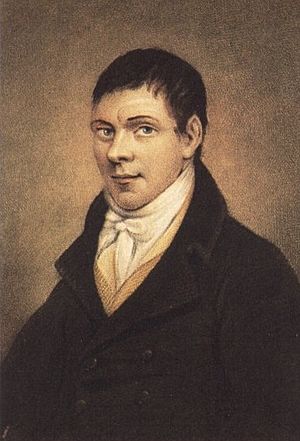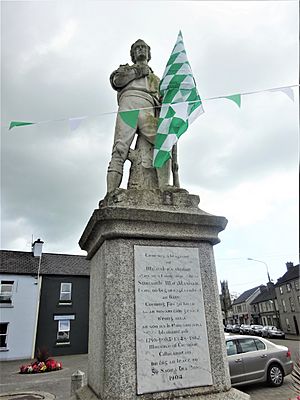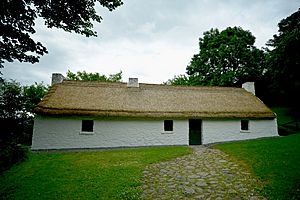Michael Dwyer facts for kids
Quick facts for kids
Michael Dwyer
|
|
|---|---|
 |
|
| Nickname(s) | "The Wicklow Chief" |
| Born | 1 January 1772 County Wicklow, Ireland |
| Died | 23 August 1825 (aged 53) Liverpool, New South Wales, Australia |
| Allegiance | Society of the United Irishmen |
| Battles/wars | 1798 rebellion Guerrilla Campaign 1799–1803 |
Michael Dwyer (born January 1, 1772 – died August 23, 1825) was a brave leader during the Irish Rebellion of 1798. He led a group called the Society of United Irishmen in battles across Wexford and Wicklow. After the main rebellion ended, Dwyer and his followers hid in the Wicklow Mountains. From there, he continued to fight against the British forces using guerrilla tactics, which means small, surprise attacks.
In 1803, a new uprising planned by his cousin, Anne Devlin, and Robert Emmet failed. Because of this, and with most of his family in prison, Michael Dwyer, known as "the Wicklow chief," agreed to a deal. In 1806, he and his closest friends were sent to New South Wales, Australia. He arrived as a free person, not a prisoner. In Sydney, he was accused of planning another Irish uprising against British rule. He was tried twice but found innocent both times. After a big event called the Rum Rebellion in 1808, he became a free man in New South Wales again. He even became the Chief of Police in Liverpool, Sydney, in 1813. In 1825, he faced money problems and was put in a special prison for people who owed money. He became very sick there and died soon after, at age 53. He never saw his four youngest children again after leaving Ireland.
In 1898, Michael Dwyer's body was moved to Waverley Cemetery in Sydney. A huge crowd of over 200,000 people came to honor him. A large monument was built there for him. It lists the names of many Irish heroes, showing that people of all religions fought for Ireland's freedom. This monument is the biggest one in the world dedicated to the 1798 Irish rebellion. It stands as a symbol of Ireland's fight for self-rule.
Contents
Michael Dwyer's Family Life
Michael Dwyer was the oldest of seven children. He had four brothers and three sisters. His family was Catholic. He went to school in Imaal, where he learned from a teacher he admired for his love of Ireland. In 1784, his family moved to Eadestown. There, they raised sheep on land they got with help from Robert Emmet's family.
In October 1798, Michael married Mary Doyle. They had four children. These children stayed in Ireland with his sister when Michael and Mary had to go to Australia.
The 1798 Rebellion in Ireland
Michael Dwyer joined the Society of United Irishmen in 1797. This group wanted Ireland to be independent from British rule. When the rebellion started in May 1798, British forces tried to scare people into giving up. They executed Dwyer's uncle and many others in a place called Dunlavin Green.
Dwyer joined other Irish fighters in Wicklow. He became a captain under General Joseph Holt. He fought in important battles like Arklow and Vinegar Hill. After a big defeat, Dwyer and Holt led their forces into the Wicklow Mountains for safety. They kept many British troops busy, stopping them from fighting elsewhere.
After General Holt surrendered in November 1798, Michael Dwyer took over as the main leader of the remaining rebels.
Fighting as a Guerrilla Leader
Dwyer and his men started a new way of fighting. They targeted local people who supported the British and attacked small groups of soldiers. They were very good at hiding and avoiding big battles. Many soldiers who had left the British army joined Dwyer's group. These new fighters were very dedicated because they knew they would not be forgiven by the government.
Because the British were always hunting for him, Dwyer had to split his group and then bring them back together. He often hid among people who supported him, including his family and friends. These supporters helped him find secret dugouts, caves, and safe houses. The government built a "Military Road" and five barracks in the Wicklow Mountains to try and catch him.
On February 15, 1799, Dwyer and about a dozen friends were hiding in three small cottages. A person who gave information to the British led many soldiers to them. Two cottages surrendered, but Dwyer and his men decided to fight in the third one. They first made sure the women and children were safe. In the gunfight that followed, the cottage caught fire. Only Dwyer was not hurt. At this point, Dwyer's friend, Sam McAllister, bravely stood in the doorway to draw the soldiers' fire. This allowed Dwyer to escape in an amazing way. The Dwyer–McAllister Cottage has been restored and is now a national monument.
Dwyer and Robert Emmet's Plans
Later, Michael Dwyer met with Robert Emmet. Emmet told him about his plans for a new uprising in Dublin. Dwyer was careful and did not want to commit his men unless Emmet's rebellion showed some early success. Emmet's uprising failed, which led to more efforts by the government to capture Dwyer. They tried to stop people from helping him by punishing those who hid his men. They also offered large rewards for information and sent thousands of troops to Wicklow. More barracks and a military road were built to control the area.
In December 1803, Dwyer finally gave up. He was promised safe travel to America. However, the government broke their promise. They held him in Kilmainham Jail until August 1805. Then, they sent him to New South Wales (Australia) as an exile, meaning he was forced to leave Ireland.
Life in Australia
Michael Dwyer arrived in Sydney on February 14, 1806, on a ship called the Tellicherry. He was given the status of a free settler, meaning he was not a convict. His wife Mary and their oldest children came with him, along with his friends. He received a large piece of land near Sydney. Even though he had hoped to go to America, Michael Dwyer was once quoted saying that "all Irish will be free in this new country" (Australia). This statement was used against him, and he was arrested in February 1807.
On May 11, 1807, Dwyer was accused of planning an Irish uprising against British rule in Australia. A witness claimed Dwyer planned to march on the government center in Parramatta. Dwyer admitted saying that all Irish would be free, but he denied planning a rebellion. He had support from John Harris, Australia's first Jewish policeman, who did not believe Dwyer was planning a rebellion. On May 18, 1807, Dwyer was found not guilty.
However, Governor William Bligh did not accept the verdict. He disliked the Irish and many other groups. Bligh arranged another trial for Dwyer. As a result, Dwyer lost his free settler status and was sent to Van Diemens Land (Tasmania) and Norfolk Island. After Governor Bligh was removed from power in the Rum Rebellion in 1808, the new Governor, George Johnston, ordered that Michael Dwyer's freedom be given back.
Michael Dwyer later became the Chief of Police in Liverpool, New South Wales from 1813 to 1820. He was dismissed from this job in October 1820 due to problems at work and losing important papers. Some historians believe he was dismissed for supporting his friend Arthur Devlin against the authorities. Another friend, Denis Molloy, faced serious charges around the same time. Dwyer and his wife Mary took care of one of Molloy's orphaned daughters.
In December 1822, Dwyer faced more money problems. He was forced to sell most of his property, including a tavern called "The Harrow Inn." This did not save him from being put in a debtors' prison in May 1825. He was released on May 24, 1825, but he had become very sick in prison. He died on August 23, 1825.
Michael Dwyer was first buried in Liverpool. His body was later moved to the Devonshire Street Cemetery in Sydney in 1878 by his grandson. In May 1898, his body was moved a second time to Waverley Cemetery. A large memorial was built there in 1900. The huge crowds at his burial and the monument's unveiling showed how much Irish-Australians respected this hero from Wicklow.
Dwyer had seven children, and many people in Australia today are his descendants. In 2002, a family reunion took place in Bungendore, near Canberra, where Dwyer's descendants met with other related Irish-Australian families. Another reunion happened in 2006 to mark 200 years since the Tellicherry arrived in Australia. One of Michael Dwyer's sons owned a hotel called The Harp Hotel around 1838. Dwyer's nephew, John Donoghoe, built a famous stone house in Bungendore around 1865. This house is a strong symbol of the hard work of early Irish Australian settlers.
Remembering Michael Dwyer
On December 9, 1900, a monument was built in Market Square in Wicklow. It honors Billy Byrne, Michael Dwyer, General William J. Holt, and William Michael Byrne. The monument faces the courthouse.
'Dwyer's Cottage', also known as the 'Dwyer–McAllister Cottage', was bought by the Irish government in 1948. President Seán T. O'Kelly was there for a special ceremony to mark the occasion.
At least two sports clubs are named after Michael Dwyer. Keady Michael Dwyer's GFC is a club in County Armagh, and Michael Dwyers is a club for young players in County Wicklow.
Michael Dwyer in Stories
Michael Dwyer is shown as one of the few survivors of the Battle of Vinegar Hill in a 2015 American musical called "Guns of Ireland."
More to Explore
Michael Dwyer was sent to Australia in 1806 as a rebel exile, not as a convict. This means he was forced to leave Ireland because of his political actions. To learn more about other Irish rebel exiles in Australia, you can look up:
- Irish-born rebels who were part of the Castle Hill convict rebellion in Sydney in 1804 and the Eureka Rebellion in Ballarat in 1854.
- The Catalpa rescue in 1876, when Irish rebels were rescued from Western Australia and brought to the U.S.A.




